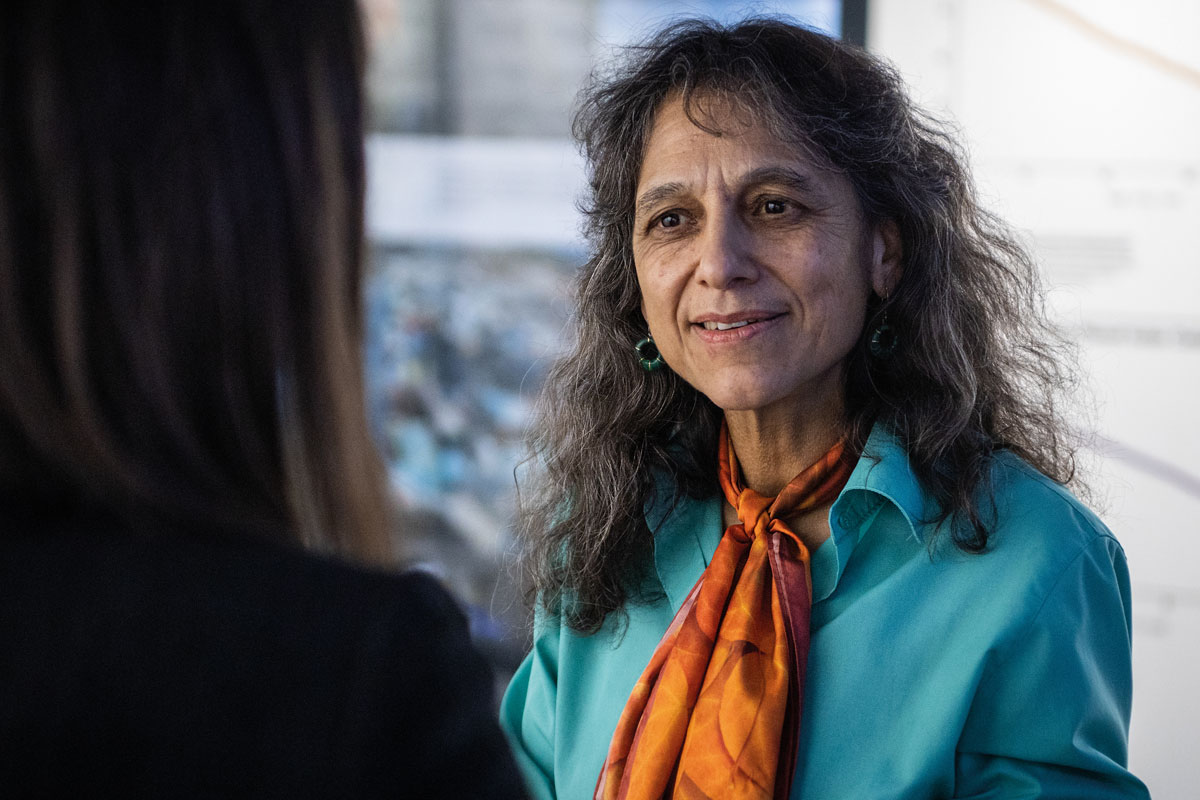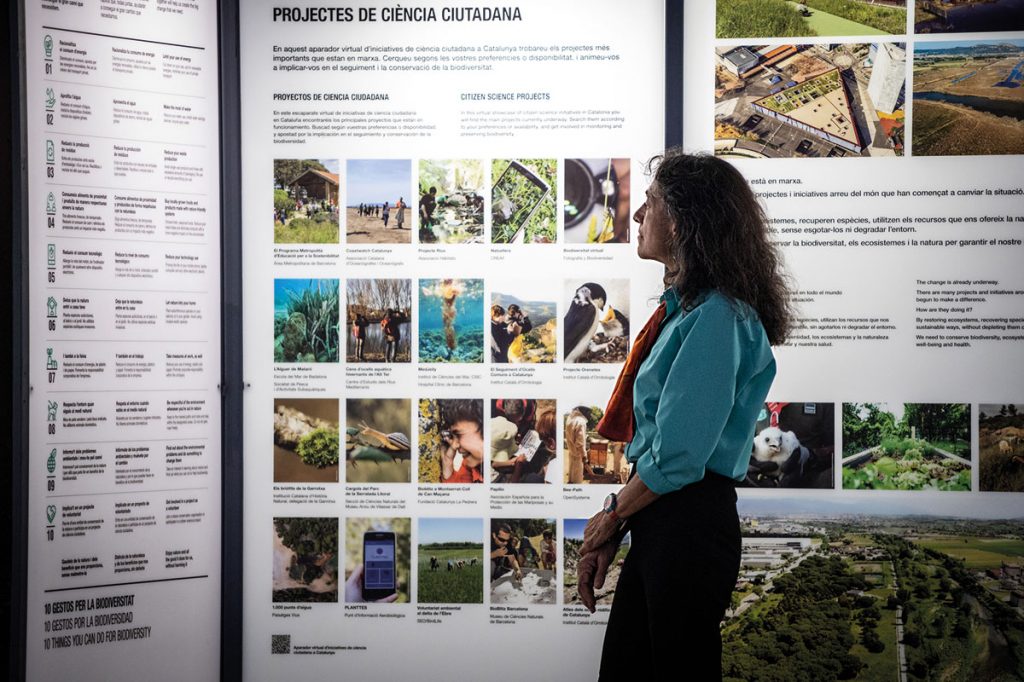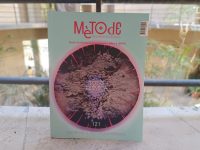Interview with Nalini Nadkarni
«Nature is more fragile than we thought»
Ecologist and Nataward 2021

Ecologist Nalini Nadkarni, known as «the queen of the forest canopy», was born in Bethesda, Maryland (USA), in 1954. She is the daughter of a Hindu father and an orthodox Jewish mother. From an early age, she was fascinated by trees, which led her to embark on an intense career of research, outreach, and activism in defence of forests. She teaches biology at the University of Utah, and her research has taken her to some quite unexpected places: using harnesses and ropes, she climbs to the top of tropical tree canopies to discover that some plant species take decades to regenerate, much longer than was previously thought. When she comes back down to the ground, she uses all her energy to spread the word about the enormous benefits of trees and nature, but also about their extreme fragility. To do so, she builds alliances and collaborations with a wide range of groups, such as artists, prisons, and the world of fashion. Now, for her exemplary career, the Natural Science Museum of Barcelona has presented her with the Nat award.
Your field of specialisation is epiphytes, non-parasitic plants growing in tropical forest canopies. These plants have no roots, but their leaves draw water from the rain. What did you discover by studying them?
We have done experiments where we removed mates of epiphytes and then looked at the rates of recolonization. Our hypothesis was that they would grow back very quickly. When you look at a branch that is just covered with these lush huge plants – some of them are gigantic – you think they are perfectly fine. I thought they would grow back after a year; but it did not take a year. It took one year, two years, three, four, five, ten, fifteen, twenty years… And even now when I go back to where I pulled those off almost 30 years ago, I can still see the patches where I took those off, because they have not come back all the way. So it means that these plants that grow in the canopy, even though they look very powerful and very strong, are actually very fragile and we really need take care of them.
Then, nature is more fragile than we thought?
Yes, that is right, exactly. And we look at these big forests and we think: «Oh, they are fine! They will go on for hundreds of years». But when we expose them to climate change or air pollution, we find very often that they are very, very fragile, very sensitive. More than we thought.
«As we get separated from nature, we lose the roots in which we evolved, in which we became humans»
How did your interest in trees came about?
When I was young, I had a big family and it was all very chaotic and so many things going on and homework and brothers and sisters and dogs and cats… So when I would climb a tree in my parents yard, it was a place that was my own, and it was very quiet, and I felt very safe, it was like the trees were protecting me, and it was fun. And I thought: «The trees have given me so much, I should give something back to the trees when I become a grown up». I thought maybe I could be a firefighter or a park ranger. I did not know how I would do it, but I just knew that I wanted to do something that would help trees because they gave me so much when I was little.
What you are saying makes me think that, in a way, trees and children are very much related, as if there is a connection. Do you see it that way, too?
Yes, every child wants to climb a tree and go up high. For me, as a biologist, it was very important that my connection with nature was made very early, as a child, that is why it becomes very strong. And I think many biologists started out, without realizing it, when they were children. They are amazed and go like: «Oh, insects!» «Oh, birds!» «Oh, trees!», and it is this fascination that makes them pursue scientific knowledge. That is why it is so important writing books for children or communicate nature to children is so important. When I talk with high-school students, I remember that for me, as a young person, it was so important to know that there were grown-ups, adults, who were working to save nature. That is why I am sad that now so many children are separated from nature, specially in big cities, where there are no trees to climb.
You are often concerned that «society is becoming increasingly separated from nature». Bearing in mind that humans are nature, are we losing touch with ourselves?
Exactly. Over evolutionary time, humans were much a part of nature. We got all of our food from nature, we knew we came from, we knew we had to protect it in order to continue getting food and shelter, and not just the practical things, but other things: the spiritual, beauty. And now we are surrounded by buildings like these instead of trees, or forest, or desert, or ocean. I think that we often believe that what makes a difference is the built world, the human world. And, of course, that is not true. We know that all our food, all of our shelter, all of our beauty really comes from nature. So, as we get separated from it, we lose the roots in which we evolved, in which we became humans. And that is why I think it is very important to engage everybody: artists, religious people, prisoners, fashion people, as well as scientists, in terms of helping to save nature.
You have certainly opened the university and collaborated with many groups. For instance, to communicate your findings, you have created partnerships with artists, who approach nature in a very different way than scientists. Can artists and scientists learn from each other?
In many ways, it seems that science and art are very different, but I think that what is important is the similarities. And I think both scientists and artist are very curious people, they ask questions. In the case of scientists, they are scientific questions, for instance, how many species of trees are there in Costa Rica? For artists, they are visual questions: What is the light that comes through the forest? And how does it change as it goes from the canopy to the ground? But ultimately, I think at the core scientists and artists are quite similar in that they want to understand the world, they want to communicate what they understand of the world to other people. I worked with a modern dancer and I thought that the modern dancer would take my information and then just dance it to communicate what I wanted to say. But instead, I found that she had her own ideas about how the forest works, what it looks like, what the interactions are with monkeys and trees… As she danced, I could not stop looking at her and thinking: «Oh, now I see the forest in a different way». And I think that goes back to curiosity, this idea that we can learn in many ways, we can communicate in many ways. In some cases, artists are better communicators than scientists are, because the people who comes to a dance performance or an art gallery want to learn through their senses, through their eyes, through their ears, whereas scientists do it more through the mind: What are the facts, what are the data? It is not like one is better than the other, they are just different. And I think that when you put them together you get to understand the whole forest or the whole ecosystem in a way that only science or only art cannot give you.
You have also collaborated with prisons. You have obtained impressive results in cases of solitary confinement, with prisoners experiencing significant improvement after just one hour seeing images of nature. Will you implement the results of this research in any way?
We have these results and we have shown that when you show nature imagery to people who have no contact with nature at all – I mean, these cells, there is no nature there – and when you show these nature videos for just one hour a day – it is not even real nature, just videos of nature – we have got these results that the violent activity went down 25%, that the men feel calmer, less aggressive. So now we are going to other prisons around the country and saying: «This seems to work, it brings down violence, it makes the man feel more connected to nature, more connected to other people». So now we are working with other prisons around the country.
Are they just videos with nature images or do they also have sound?
They also include sound. But we have done experiments also where we separated those out. We had a grant from the National Geographic Society to understand whether the men were responding to the video or the audio. First, we showed the video without sound and then we showed them the sound without the video, and we found that there was more response with the videos than with sound, but the sound still had an effect. Another thing that we looked at is what type of nature had more effect – forests, oceans, streams, deserts, etc. And what we found is there was no single ecosystem that had the biggest effect. Depending on the men, the forests were more relaxing, other men found the desert better, other men found the ocean better.

Photo: Marc Brugat
I recently read English psychiatrist Sue Stuart-Smith’s The well-gardened mind, which states that cortisol levels are noticeably higher when we are in town, and that just half an hour around nature, cortisol levels already start declining.
Yes, that is right. And that is what we measured in that study separating the audio from the visual. We measured cortisol levels. And also what is known as the galvanic skin response, whether are they perspired, whether their skin was wet. And we had sensors that we put on their fingers, as well as taking saliva to look at their cortisol levels. So that is what we actually use to measure stress levels, their cortisol levels.
You have also collaborated with the fashion industry in the defence of trees. Why this sector?
Most biologists do not care about what they wear, they look terrible. But I also have learned that many people pay a lot of attention to clothes – they have to do with their identity, with who they want to look like today. I thought that was very powerful. And many people wear clothes that have brand names. So you are making a statement when you wear clothes. I thought: «Why not have nature be a part of that?». I have been working with fashion designers in New York City to do this scarf, for example: it shows an image of real nature, these are real leaves. We are using clothing as a way to communicate people the beauty and the importance of trees. If someone tells you: «I like your scarf», then you can start talking about trees and explain that these are aspen trees, and then go ahead and tell them that there is a group that is protecting trees… Because nature is so beautiful! Why not wear it? Why not identify ourselves with nature?
And I guess the whole project is about involving designers in working in a way that is as environmentally friendly as possible.
Indeed. We use dyes that do not pollute, recycled materials… Because the message of this scarf or any clothes is not just that these are the leaves of a real tree, which is great. We need to think of a more sustainable way to create fashion. And I have noticed that there is a lot of people in the fashion industry who are interested in making clothes more sustainable.
«There are few communication pathways between the researchers who understand climate change and the policy makers who can actually make a change»
This sort of networking is interesting. You often use the metaphor of a tapestry where everything is connected. Is that the case with nature?
Right. I think that nature works that way, that nature is itself a tapestry. You get birds interacting with flowers, you get monkeys dispersing seeds, you get the sunlight interacting with trees to do photosynthesis: everything is a network. But I think that when we also try to understand how we can protect nature, we also need to use a network or a tapestry. It is not enough to have science, we also need to have art in order to communicate and inspire people, we need poetry to inspire people, we need economics to say how much will it cost to protect this, we need businesspeople to assess how much money we need, we need all kinds of people, all sorts of knowledge in order to protect that tapestry of nature. So it is sort of a tapestry to protect nature. And one of the reasons I use this metaphor is that you are not just mixing to things together – red paint and white paint makes pink paint, mix them together and you lose the red and white. The thing about a tapestry is that each thread remains pure. For the science thread, you need scientists who do good science, you want to use a writer to describe that science. You need a really great writer. And then when you put those together, they make a different picture, they make a new picture in the tapestry, but keeping that threads strong and pure.
If we took this tapestry and looked at the thread of the university, can we say that the universtity is doing enough to understand and stop climate change?
I think the work of universities is to teach young people content, information, and also to do research. And for really fifty years now, scientists had known about climate change, and they have worked to understand it, they have made mathematical models, they have made maps of where climate is going to change, they have understood that more storms coming, more floods are coming, more fires are coming… But they tend to stop there. Then is up to communicators, museums, who take that information and describe it and communicate it to the public. And then it is also up to policy makers to say: We need to do more to restrict how much gas we release or whether we have public transportation… I think the problem is that there are few communication pathways between the researchers who understand the problem and the solutions and the people, the policy makers who can actually make a change. And that is why I think it is very slow. Even though we have had the information for fifty years that climate change is happening, the policy makers did not have that information, or even if they did, they do not want to transmit unpopular messages such as «You have to take the subway instead of driving your own car».
People like you can inspire young women to pursue a career in science. Do you think that the role of women in science is improving and has become more visible?
I think it is. I know that when I started out, at your age, there were not many women to look at, among professors or as role models. I think it is very important for young girls and young boys to see that women are capable of doing science, capable of doing art or journalism, or anything that they wish to do in order to contribute to society. I personally do not feel that I am discriminated against, but I do not deny that other women have felt discrimination, or that many, many women feel that they are overlooked or not given as many opportunities. If you look at the numbers, at least in the United States, among graduate students, people who are going to be scientists, it is about fifty-fifty, but when you look at the faculty members, the president of the university, the deans, the provost, and the department chairs, there are definitely more men than women. I think it will take time for those women who are in science now at a young age to get to those positions of power, and I think in another 20 years we will see more equality, more inclusion.





